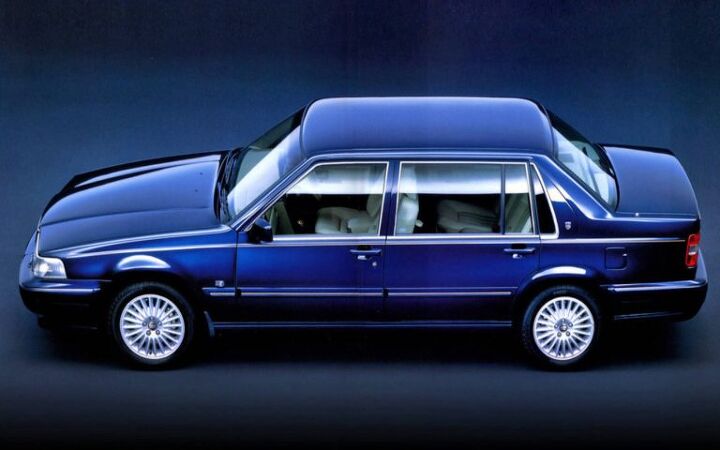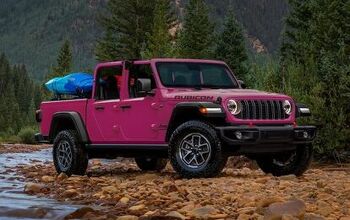Rare Rides: A Very Exclusive 1998 Volvo S90 Royal Herms

Long before the S90 moniker was applied to a Chinese-produced front-drive car, it was (for a short while) the last chapter in a series of luxurious rear-drive Volvo sedans. What we have here is a last-of moment for Volvo, and a very rare one at that.
Presenting the S90 Royal Hermès.
Of course in the beginning it wasn’t called an S90 at all, rather 940 or 960. The 900 Series was the 1990 replacement for the 700 Series in production since 1982. We’ve featured a special 700 Series car here before – the Bertone-edited 780 coupe – but the vast majority of 700s sold were of the sedan or wagon variety.
There was some 700 and 900 production overlap, but after 1992 the 900 was on its own. 900 was not an all-new car for Volvo but rather a rework of the 700. Everything aft of the C-pillar on the sedan was new, but most other things carried over including options and indeed drivetrains. The first model introduced was the 940, which correlated to the prior 740 and shared its dashboard and sheet metal ahead of the A-pillar. For 1991 the 960 debuted as Volvo’s top-tier flagship. As the name suggested, it was a replacement for the prior 760. 960 had its own exterior appearance, an independent rear suspension, nicer interior, and a unique dashboard exclusive to that model.
Though the two 900 Series cars shared some engines, the new and exciting DOHC 2.9-liter inline-six was exclusive to the 960. With 24 valves the engine produced 204 horses. It was often colloquially called the “white block” because of its unpainted aluminum block. Other engines for the 960 were of inline-four, smaller inline-six, or V6 varieties. Transmissions were of four-speeds if automatic, or four- or five-speed if manual.
Unlike its 700 predecessor, the 900 was never offered as a luxurious coupe. Both 940 and 960 were built in four-door sedan and wagon guises. The North American market largely shunned the 940 in favor of the cheaper front-drive 850 or the high-lux 960. In 1995 Volvo dropped the 940 in North America and focused on the other two models. 940 continued elsewhere through 1998.
The 960 received a facelift for the ’95 model year, after incremental fiddling and improvements for ’92 to ’94. Only six-cylinder power remained from 1995 onward, paired to a brand new multi-link rear suspension. In 1996, markets outside the US relabeled the 960 sedan and wagon as S90 and V90 respectively, to coordinate with Volvo’s new naming scheme. That change didn’t occur until 1997 for North America, and by then the 960 was not long for the world. Production of the 960 was finished by February 1998, but not before a very special version had its day.
In markets outside the US, Volvo sold a super luxurious version 960 and S90 called the Executive. Six inches longer than the normal sedan, it had a redesigned C-pillar and much longer rear doors. It also featured a rear center console and lots of wood and additional electric niceties. Based on the Executive was the ultimate S90, the Royal Hermès.
Not the first time Volvo worked with the French handbag company, the Hermès took S90 luxury to the next level. Focused more seriously on rear passenger comfort, its Royal badging did not disclose the discrete rear fridge or the fact that the interior was trimmed in high-quality Hermès leather. It was a fitting end to Volvo’s last full-size, rear-drive car.
Today’s Royal Rare Ride is located in Japan and is listed at auction for a present bid of $27,000. With low miles, it looks almost like new in navy over ivory. And that’s good because interior trim replacements are surely non-existent.
[Images: Volvo]

Interested in lots of cars and their various historical contexts. Started writing articles for TTAC in late 2016, when my first posts were QOTDs. From there I started a few new series like Rare Rides, Buy/Drive/Burn, Abandoned History, and most recently Rare Rides Icons. Operating from a home base in Cincinnati, Ohio, a relative auto journalist dead zone. Many of my articles are prompted by something I'll see on social media that sparks my interest and causes me to research. Finding articles and information from the early days of the internet and beyond that covers the little details lost to time: trim packages, color and wheel choices, interior fabrics. Beyond those, I'm fascinated by automotive industry experiments, both failures and successes. Lately I've taken an interest in AI, and generating "what if" type images for car models long dead. Reincarnating a modern Toyota Paseo, Lincoln Mark IX, or Isuzu Trooper through a text prompt is fun. Fun to post them on Twitter too, and watch people overreact. To that end, the social media I use most is Twitter, @CoreyLewis86. I also contribute pieces for Forbes Wheels and Forbes Home.
More by Corey Lewis
Latest Car Reviews
Read moreLatest Product Reviews
Read moreRecent Comments
- Lou_BC Well, I'd be impressed if this was in a ZR2. LOL
- Lou_BC This is my shocked face 😲 Hope formatting doesn't fook this up LOL
- Lou_BC Junior? Would that be a Beta Romeo?
- Lou_BC Gotta fix that formatting problem. What a pile of bullsh!t. Are longer posts costing TTAC money? FOOK
- Lou_BC 1.Honda: 6,334,825 vehicles potentially affected2.Ford: 6,152,6143.Kia America: 3,110,4474.Chrysler: 2,732,3985.General Motors: 2,021,0336.Nissan North America: 1,804,4437.Mercedes-Benz USA: 478,1738.Volkswagen Group of America: 453,7639.BMW of North America: 340,24910.Daimler Trucks North America: 261,959






































Comments
Join the conversation
We wouldn't be having these speed camera issues if speed limits weren't so low to begin with. It's almost as though traffic planners use the "Great Aunt Mildred Algorithmn" when setting speed limits: What speed would be most comfortable for Great Aunt Mildred? Meanwhile, the rest of us are either bored to death or drive in fear of getting pinched. Who in their right mind can drive 25 mph ANYWHERE? How about 15 mph school zones where there's nary a child in sight? The list goes on, but I am some tired of it.
I just bought a 2001 Volvo C70. Ragtop. Turbo. Manual. Transverse engine. Five-cylinder. All I've done with it is wrench on it. I haven't even driven it yet. Idiocy abounds.